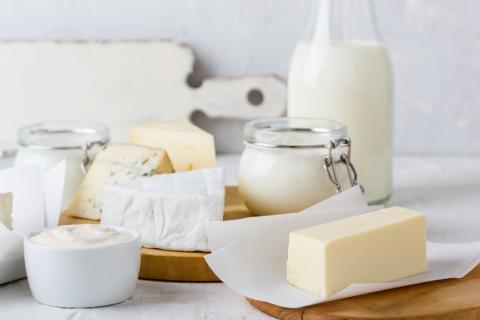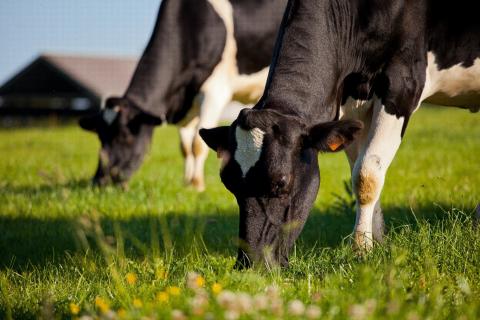4 June 2020
Dr Cate Williams: IBERS, Aberystwyth University.
- The lipid profile of milk is easily manipulated through diet, reducing the amount of saturated fats and boosting levels of unsaturated fats.
- Grazing dairy cows on a diverse sward or adding supplementary oilseeds works to increase levels of conjugated linoleic acid, Omega 3 and 6 fatty acids.
- Another option for adding value to milk may be the production of melatonin-rich milk which promotes sleep.
- There is evidence of high levels of melatonin in milk taken at night, although further research is needed to establish an optimum dose and to consolidate inconsistent results.
As farmers are urged to improve the efficiency, productivity and sustainability of their businesses, many are looking to add value to their produce, for example, producing organic or grass-fed milk, undertaking some processing themselves and making their own cheese, butter, yoghurt or ice cream. Other avenues for adding value to milk may include altering the composition or qualities of the milk itself, for example, there is a strong body of evidence to support the effect of diet on milk fat profiles, with the potential to reduce saturated fat content and increase levels of health beneficial fats. Another, more novel concept, is ‘night milking’ – milking cows at night to produce milk with a higher concentration of melatonin, the sleep-promoting hormone. Nearly a third of the UK population suffers from insomnia, a particular problem for the elderly whose own melatonin production declines with advancing age. Scientific research suggests that there is potential to produce milk containing higher levels of the hormone which may, in turn, add value to milk.
The fat profile of milk
In recent times, consumers in developed countries have shown a clear preference for skimmed (≤0.3% fat) and semi-skimmed (≤1.7% fat) milk as well as other low-fat milk products. A similar trend can be observed for butter, which took a serious hit in popularity upon the introduction of margarine. Touted as a healthier alternative to butter, margarine has grown in popularity across the globe. However, an increasing body of scientific research has revealed that margarine contains a high proportion of trans-fats which are consistently linked to chronic diseases in humans, particularly coronary heart disease. The saturated fats present in butter and other dairy products, on the other hand, have not been linked to cardiovascular diseases, in fact, quite the opposite. Some studies have found that saturated fatty acid (SFA), stearic acid (abundant in animal-derived products) reduces harmful cholesterol levels. Nevertheless, there is a consumer trend indicating interest in low-fat products or those with a ‘healthier’ fat profile. At the same time, the most sensitive component of milk to manipulation is fat which leaves the potential to manipulate the lipid profile of milk in response to consumer demands. Such products would fill a niche in the market and have the potential to fetch a premium.
There is also consumer interest in grass-fed ruminant products, particularly beef and to a lesser extent milk (more often focus is directed towards organic milk, commonly confused with ‘grass-fed’). The main reason behind this interest is the perceived benefits in animal health and welfare and to a lesser extent, healthiness of products from a pasture-fed animal. Grass is an excellent source of naturally occurring, health beneficial polyunsaturated fats (PUFA), however, because of their toxicity to the rumen microbes, they are saturated with hydrogen upon reaching the rumen. It is this process that determines the SFA content of ruminant products like meat and milk. The fat content of milk is further complicated, however, by the synthesis of short to medium-chain SFA by the udder itself. This synthesis of fats in the udder can account for 20-30% of total fat in milk, with the remaining 70-80% coming from the bloodstream, as dictated by diet and digestive processes. As the diet is responsible for up to 80% of the fats present in milk, it is no surprise that feeding has a significant effect on fat composition.
Overall, the fat profile of milk from grazing cows is more beneficial to human health than milk from those fed diets based on silage or a total mixed ration (TMR). Milk produced from pasture contains lower levels of SFA and higher levels of PUFA – including conjugated linoleic acid (CLA). Experiments have found that CLA content in milk, in particular, is extremely responsive to diet. Milk from grazing cows contained more than double the amount of CLA when compared to those eating a combination of pasture, hay and concentrates. These beneficial changes in lipid composition are maintained and even enhanced when a diverse pasture containing herbs, legumes and grasses is offered. Research has found that both yarrow and chicory have very good nutritional profiles, containing high levels of PUFA and crude protein. Milk from cows grazed on a species-rich pasture (containing chicory or plantain) contains higher levels of PUFAs – notably, CLA and omega-3 fatty acids, which are particularly beneficial in terms of heart health. Outside of milk composition, diverse swards also offer a plethora of environmental benefits: an increase in biodiversity, enrichment of natural habitats and a reduction of nitrogen levels in the urine.
A grazing diet may also be mimicked by the addition of oilseeds to the diet – this provides enhanced levels of PUFA, albeit from a different source. Studies using rapeseed in dairy cow diets found an increase of 10% in PUFA concentration and 40% in CLA content in milk when compared to those fed a standard TMR. The addition of flaxseed was also able to increase the range of PUFAs present in milk (including omega 3s, 6s and CLA) and decreased some types of SFA. The second most abundant SFA in milk is palmitic acid, which, unlike stearic acid, can have negative effects on human health. But feeding flaxseed produced more stearic acid and less palmitic, resulting in a more health beneficial lipid profile. Evidence for the effects of linseed is also available, with studies showing a 7% decrease in milk SFA content and a significant increase in PUFA – particularly omega 3 fatty acids. As a side effect, many studies have noted the tendency for increased milk production when feeding additional fat sources, although protein concentration has been observed to decrease in some cases. When considering supplementing with additional fat, it is also important to remember that fats should not exceed 5% of the ruminant diet.
Night milk
Another, different option for adding value to cow’s milk may be influencing melatonin content. Melatonin is a hormone produced by the pineal gland in the brain that regulates the sleep-wake cycle, or circadian rhythm. During daylight, the pineal gland is inactive, producing very little melatonin which contributes to the ‘wake’ cycle, instead, the hormone cortisol works to keep us alert and responsive (Figure 1). However, during darkness (for humans usually around 9 pm) the pineal gland activates and begins producing melatonin whilst blood cortisol levels decrease (Figure 1). As melatonin concentrations accumulate in the blood, alertness is reduced, and the sleep cycle begins. High melatonin levels last for approximately 12 hours and around 9 am the cycle begins again (Figure 1). The same cycle can be observed in most mammals, dairy cattle included and a clear daily pattern of melatonin production can be observed in cow’s milk.
Figure 1: Diagrammatic representation of cortisol and melatonin levels during the sleep-wake cycle.
Human studies have found that melatonin is heavily involved in sleep disorders, such as insomnia, and contributes to the feeling of jet lag. Furthermore, as humans age, the ability to produce melatonin declines which results in sleep problems in the elderly. This leaves a clear niche in the market for melatonin-based products, which may offer a more ‘natural’ aid to sleep than other over the counter medications on the market. In addition to its role in the sleep-wake cycle, melatonin acts as an antioxidant in humans, helping to regulate the immune response and acting as an anti-inflammatory compound. There is, therefore, the scope for milk containing high levels of melatonin to be used as a ‘nutraceutical’, with milk offering an excellent source of vitamins and minerals and the hormone melatonin acting as both a sleep aid and antioxidant.
In humans, peak night-time values of melatonin can fall anywhere between 10 and 60 picograms (pg) per mL and a vague, average figure of >0.3 mg melatonin is required per day for usual induction of sleep and relaxation. Despite this established figure, the EU Register of Nutrition and Health (EURH) dictates that to be classed as ‘melatonin-rich’ foods must contain 1 mg/portion of melatonin (or 0.5 mg for the treatment of jet lag). Milk melatonin concentrations achieved in cow’s milk vary from study to study but have been reported as high as 30 pg/mL taken at 4:30 am with no artificial light supplied during the night. Other studies have achieved concentrations of 6.9 pg/mL when milking at 4 am, a significant increase (of over 400%) compared to 0.16 pg/mL in milk taken at noon. There may also be a seasonal effect, as studies have reported a doubling in melatonin concentrations in milk taken during the summer months (August) when compared to milk taken in February. Overall, it has been established that milk taken between the hours of 12 and 5 am contains the highest levels of melatonin. Some results also suggest that melatonin might be heat-resistant and that the commercial process of pasteurisation may not affect its structure.
Overall, there is a compelling body of evidence that melatonin-rich milk can alleviate sleep problems such as insomnia, particularly in the elderly. There are also many studies demonstrating highly variable levels of melatonin in cow’s milk taken at night, from 6.9 to 30 pg/mL. Such inconsistent results indicate the need for further study, as some suggest a seasonal effect whilst consideration has not yet been given to other factors, such as parity, stage in lactation, animal age and a range of environmental variables. Such environmental factors would become especially important outside of a research setting, on a commercial dairy. Indeed, the European Innovation Partnership (EIP) Wales project investigating the production of night milk demonstrated that in an industrial setting, the production of melatonin-rich milk may be more complicated. The project was able to produce milk containing ≤5 ng/mL, a value which would give 1,250 ng/250 mL portion. Whilst this does not meet the required 1 mg threshold dictated by the EURH, it does exceed naturally occurring levels in humans (of 10-60 pg/mL). To establish an optimum dose for melatonin in humans further research is required, as natural production varies considerably between individuals. The project also suggested that melatonin may not be affected by the process of pasteurisation, with levels not differing significantly between raw and pasteurised samples.
Click here to view the EIP Night Milk project.
Summary
There is great potential to add value to cow’s milk, through diversification and additional processing or by manipulating milk composition. It is well established that the ruminant diet strongly affects the composition and in particular the fatty acid profile of milk. Grazing dairy cows, particularly on a mixed, diverse pasture consistently increases levels of PUFA in the milk – including CLA, omega 3 and omega 6 fatty acids, all of which are beneficial to human health. Concurrently, the amount of saturated fat is reduced and/or converted into stearic acid, a safer SFA that can regulate cholesterol levels. Night milking is also an option to produce melatonin-rich milk. Melatonin is the hormone responsible for sleep and has been proven to help with insomnia, particularly in the elderly. Studies have found that it is possible to produce milk with high levels of melatonin if cows are milked at night – between 12 and 5 am. However, these results are inconsistent, varying from 6.9 to 30 pg/mL of melatonin and further research is needed to evaluate external factors which may affect melatonin production, such as, season, animal age, parity and stage in milk production. There is also no published figure for the optimum dosage of melatonin in humans, as natural production varies between individuals.



